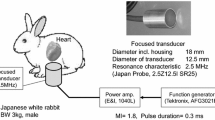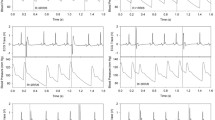Abstract
Purpose
We previously reported that acoustic radiation force impulse (ARFI) with concomitant administration of perfluorobutane as an ultrasound contrast agent (UCA)-induced arrhythmias at a mechanical index (MI) of 1.8 or 4.0 in a rabbit model. The present study identified the location of arrhythmias with a MI < 1.8 using a new system that can transmit ARFI with B-mode imaging.
Methods
Under general anesthesia, six male Japanese white rabbits were placed in a supine position. Using this system, we targeted ARFI to the exact site of the heart. ARFI exposure with MI 0.9–1.2 was performed to the right or left ventricle of the heart 2 min after UCA injection.
Results
ARFI with a MI lower than previously reported to rabbit heart evoked extrasystolic waves with single UCA infusion. Arrhythmias were not observed using ARFI without UCA. Extrasystolic waves were observed significantly more frequently in the right ventricle group than in the left ventricle group, with arrhythmias showing reversed shapes. No fatal arrhythmias were observed.
Conclusion
ARFI applied to simulate clinical conditions in rabbit heart evoked extrasystolic waves with single UCA infusion. The right ventricle group was significantly more sensitive to ARFI exposure, resulting in arrhythmias, than the left ventricle group. The shapes of PVCs that occurred in the right ventricle group and the left ventricle group were reversed. Ultrasound practitioners who use ARFI should be aware of this adverse reaction, even if the MI is below the previously determined value of 1.9.







Similar content being viewed by others
References
Nightingale K. Acoustic radiation force impulse (ARFI) imaging: a review. Curr Med Imaging Rev. 2011;7:328–39.
Nightingale K, Bentley R, Trahey G. Observations of tissue response to acoustic radiation force: opportunities for imaging. Ultrason Imaging. 2002;24:129–38.
Nightingale K, Soo MS, Nightingale R, et al. Acoustic radiation force impulse imaging: in vivo demonstration of clinical feasibility. Ultrasound Med Biol. 2002;28:227–35.
Doherty JR, Trahey GE, Nightingale KR, et al. Acoustic radiation force elasticity imaging in diagnostic ultrasound. IEEE Trans Ultrason Ferroelectr Freq Control. 2013;60:685–701.
Hsu SJ, Bouchard RR, Dumont DM, et al. In vivo assessment of myocardial stiffness with acoustic radiation force impulse imaging. Ultrasound Med Biol. 2007;33:1706–19.
Ishiguro Y, Nitta N, Taniguchi N, et al. Ultrasound exposure (mechanical index 1.8) with acoustic radiation force impulse evokes extrasystolic waves in rabbit heart under concomitant administration of an ultrasound contrast agent. J Med Ultrason. 2001;2016(43):3–7.
Ishiguro Y, Sasanuma H, Nitta N, et al. The arrhythmogenic effect of ultrasonic exposure with acoustic radiation force (ARF) impulse on the rabbit heart with ultrasound contrast agent perfluorobutane. J Med Ultrason. 2001;2015(42):47–50.
Nitta N, Ishiguro Y, Sasanuma H, et al. Experimental system for in-situ measurement of temperature rise in animal tissue under exposure to acoustic radiation force impulse. J Med Ultrason. 2001;2015(42):39–46.
Takayama N, Ishiguro Y, Taniguchi N, et al. The effect of ultrasound with acoustic radiation force on rabbit lung tissue: a preliminary study. J Med Ultrason. 2001;2016(43):481–5.
Tran TA, Le Guennec JY, Babuty D, et al. On the mechanisms of ultrasound contrast agents-induced arrhythmias. Ultrasound Med Biol. 2009;35:1050–6.
Miller DL, Averkiou MA, Brayman AA, et al. Bioeffects considerations for diagnostic ultrasound contrast agents. J Ultrasound Med. 2008;27:611–32 ((quiz 33–36)).
van Der Wouw PA, Brauns AC, Bailey SE, et al. Premature ventricular contractions during triggered imaging with ultrasound contrast. J Am Soc Echocardiogr. 2000;13:288–94.
Whittingham TA. WFUMB Safety Symposium on Echo-Contrast Agents: exposure from diagnostic ultrasound equipment relating to cavitation risk. Ultrasound Med Biol. 2007;33:214–23.
Kirchhof PF, Fabritz CL, Zabel M, et al. The vulnerable period for low and high energy T-wave shocks: role of dispersion of repolarisation and effect of d-sotalol. Cardiovasc Res. 1996;31:953–62.
Sontum PC, Ostensen J, Dyrstad K, et al. Acoustic properties of NC100100 and their relation with the microbubble size distribution. Invest Radiol. 1999;34:268–75.
Toft KG, Hustvedt SO, Hals PA, et al. Disposition of perfluorobutane in rats after intravenous injection of Sonazoid. Ultrasound Med Biol. 2006;32:107–14.
Kanda Y. Investigation of the freely available easy-to-use software “EZR” for medical statistics. Bone Marrow Transplant. 2013;48:452–8.
Shiina T, Nightingale KR, Palmeri ML, et al. WFUMB guidelines and recommendations for clinical use of ultrasound elastography: Part 1: basic principles and terminology. Ultrasound Med Biol. 2015;41:1126–47.
Dalecki D, Keller BB, Raeman CH, et al. Effects of pulsed ultrasound on the frog heart: I. Thresholds for changes in cardiac rhythm and aortic pressure. Ultrasound Med Biol. 1993;19:385–90.
Dalecki D, Raeman CH, Child SZ, et al. Effects of pulsed ultrasound on the frog heart: III. The radiation force mechanism. Ultrasound Med Biol. 1997;23:275–85.
MacRobbie AG, Raeman CH, Child SZ, et al. Thresholds for premature contractions in murine hearts exposed to pulsed ultrasound. Ultrasound Med Biol. 1997;23:761–5.
Acknowledgements
This work was supported by a Grant-in-Aid for Scientific Research B (23300194) and C (26350544) from the Japan Society for the Promotion of Science and a grant from the Research and Development Committee Program of the Japan Society of Ultrasonics in Medicine. This work was also supported in part by a Grant-in-Aid of The Foundation for Development of the Community. This work was also supported in part by a project of the Ultrasound Equipment and Safety Committee of the Japanese Society of Ultrasonics in Medicine. The role of the sponsors was conduct of the experiments and preparation of the article.
Author information
Authors and Affiliations
Corresponding author
Ethics declarations
Conflict of interest
The authors declare that there are no conflicts of interest.
Ethical statements
All institutional and national guidelines for the care and use of laboratory animals were followed.
Additional information
Publisher's Note
Springer Nature remains neutral with regard to jurisdictional claims in published maps and institutional affiliations.
About this article
Cite this article
Rifu, K., Sasanuma, H., Takayama, N. et al. Acoustic radiation force impulse under clinical conditions with single infusion of ultrasound contrast agent evoking arrhythmias in rabbit heart. J Med Ultrasonics 48, 137–144 (2021). https://doi.org/10.1007/s10396-021-01085-3
Received:
Accepted:
Published:
Issue Date:
DOI: https://doi.org/10.1007/s10396-021-01085-3




